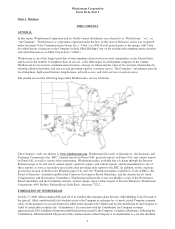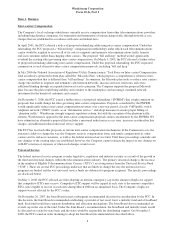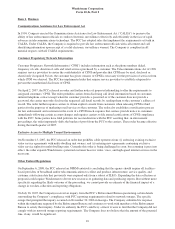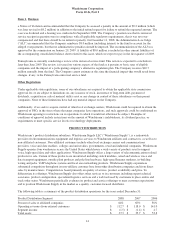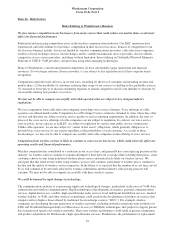Windstream 2008 Annual Report Download - page 59
Download and view the complete annual report
Please find page 59 of the 2008 Windstream annual report below. You can navigate through the pages in the report by either clicking on the pages listed below, or by using the keyword search tool below to find specific information within the annual report.
Windstream Corporation
Form 10-K, Part I
Item 1. Business
STATE REGULATION
Local and Intrastate Rate Regulation
Most states in which our ILEC subsidiaries operate provide alternatives to rate-of-return regulation for local and
intrastate services, either by law or PSC rules. We have elected alternative regulation for our ILEC subsidiaries in all
states except New York. We continue to evaluate alternative regulation options in New York where our ILEC
subsidiary remains subject to rate-of-return regulation.
The following summary sets forth a description of the alternative regulation plan for each of the states in which
alternative regulation options exist:
• Our regulated Alabama wireline subsidiary has operated since 2005 under the price flexibility plan established by
the PSC. Under this plan basic residential local service rates are capped for two years. In 2005, the legislature
passed the Alabama Communications Reform Act of 2005. Under this Reform Act, only stand-alone basic service,
network access services and certain calling features remain regulated after February 1, 2007. We have elected to
be regulated under the Reform Act, effective February 1, 2007.
• Windstream Arkansas has operated since 1997 under an alternative regulation plan established by Arkansas
statute. Under this plan, basic local rates and access rates may be adjusted annually by up to 75 percent of the
annual change in the Gross Domestic Product-Price Index (“GDP-PI”). Other local rates may be changed without
PSC approval and become effective upon the filing of revised tariffs. Windstream Communications Southwest, a
separate subsidiary with operations in Texas, has a reciprocity agreement with the Arkansas PSC that provides
that rates approved by the Texas PSC for Texarkana, TX, are deemed approved in Texarkana, AR. This
reciprocity agreement ensures that all customers in Texarkana are charged the same rates.
• Our regulated Florida wireline subsidiary operates under alternative regulation established by Florida statute.
Under this plan, basic local rates may be increased once in any twelve-month period by an amount not to exceed
the twelve-month change in the GDP-PI less 1 percent. Non-basic services are grouped by type into categories in
accordance with PSC rules. We may increase rates for non-basic services as long as the annual increase for any
such category does not exceed 6 percent in any twelve-month period. Non-basic rates can be increased by up to 20
percent annually in exchanges where another local provider is providing services.
• Our regulated Georgia wireline subsidiaries operate under an alternative regulation plan established by Georgia
statute. Under this plan, basic local rates may be increased annually based on the annual change in GDP-PI. Other
local rates may be increased by filing revised tariffs.
• We have two regulated operating subsidiaries in Kentucky. On July 12, 2006, both elected a new form of
alternative regulation approved by the Kentucky General Assembly during the 2006 legislative session. The new
law freezes basic rates for electing companies for five years and then gives the PSC jurisdiction over rate
adjustments for basic services thereafter. Rates for non-basic services may be adjusted without PSC approval
either by filing revised tariffs or de-tariffing non-basic services and providing customer service agreements to
end-users. The new law caps rates for intrastate switched access services and deems an electing utility’s rates,
charges, earnings, and revenues to be just and reasonable. Wholesale interconnection arrangements between or
among companies, as well as complaints for basic service and service quality metrics remain under the
jurisdiction of the PSC.
• On February 23, 2006, the Governor of Mississippi signed into law HB 1252, which substantially reduced state
PSC regulation of wireline telecommunications services in Mississippi. The law became effective July 1, 2006.
Under the new law, only stand-alone basic service and intrastate network access services remain regulated by the
Mississippi Public Service Commission. Additionally, the PSC approved a rural ILEC price regulation plan as an
alternative form of regulation for rural companies. Effective June 13, 2007, Windstream elected to be regulated
under the rural ILEC price regulation plan. Under this plan, Windstream is required to meet certain service quality
metrics and to be able to offer high-speed Internet services to at least 80 percent of its customers by June 13, 2009.
At December 31, 2008 we exceeded the above broadband requirement.
11



